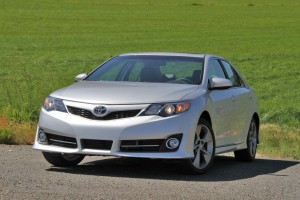
Toyota was forced to make major changes to the 2012 Camry's design when dealers gave the original look a thumbs-down.
It was definitely not the sort of reception Toyota executives were anticipating – but it was a clear eye-opener when they took a prototype of the all-new Camry sedan to show U.S. dealer during the spring of 2010.
“They were not thrilled,” admits Jim Lentz, Toyota’s top U.S. executive. “They wanted an extra 10%,” especially when it came to what Lentz now admits was a dull exterior design. “So, that’s what we gave them.”
The meeting led to some dramatic changes to what was launched, several months ago, as the 2012 Toyota Camry – the final production version of the sedan getting new front and rear fascias, rockers and tail lamps as well as some modest interior tweaks.
But more importantly, the face-off with dealers has led Toyota to think differently about what it brings to market, says Lentz. “Staying closer to our dealers (gets us) much closer to our customers,” he explains, adding that the message learned is that Toyota cannot simply market itself as a company producing high-quality cars anymore.
“The cost of poker today is quality, reliability and dependability,” he told TheDetroitBureau.com. It’s now hard to find a maker that doesn’t deliver reasonably good QRD. “In the past that was the point of distinction.”
So, Toyota products will need to deliver “much more impressive dynamics and much exciting design,” he said. Where a Toyota has traditionally been something of an automotive appliance, it now must offer “a lot more fun to drive.”
“Quite frankly,” the executive acknowledged, “we were slow to pick up on that.”
But that new approach fits with the philosophy of Toyota CEO Akio Toyoda, grandson of the company’s founder, insisted Lentz, following the preview of the maker’s new Lexus GS F Sport sedan at the annual SEMA Show in Las Vegas.
Taking a more dynamic approach to design and performance will become all the more important as Toyota rebuilds. The maker was slammed by a safety and quality scandal touched off by a massive recall in late 2009. Eventually, more than 10 million vehicles were called back and Toyota paid millions in record penalties levied by the U.S. National Highway Traffic Safety Administration.
Just as it was recovering from that issue it was slammed by the March 11 earthquake and tsunami that crippled the Japanese auto industry. Since then, the maker’s worldwide assembly network has lost about 700,000 units of production.
U.S. sales have been down, for most of the last half-year, by double-digit levels, though the year-over-year deficit was a modest 4% in October, suggesting production and inventories are getting back to normal, noted Lentz.
“We feel the past is behind us,” he said during an impromptu interview. But while the executive insisted “We’re feeling really bullish,” he conceded that changing the perception of the brand to something more dynamic will be critical if Toyota hopes to continue gaining share in the increasingly aggressive automotive market.
